Urtica dioica
| Urtica dioica | |
|---|---|
| | |
| Urtica dioica subsp. dioica | |
| Scientific classification | |
| Kingdom: | Plantae |
| Clade: | Angiosperms |
| Clade: | Eudicots |
| Clade: | Rosids |
| Order: | Rosales |
| Family: | Urticaceae |
| Genus: | Urtica |
| Species: | U. dioica |
| Binomial name | |
| Urtica dioica L. | |
Urtica dioica, often called common nettle, stinging nettle (although not all plants of this species sting) or nettle leaf, is a herbaceous perennial flowering plant in the family Urticaceae. It is native to Europe, Asia, northern Africa, and western North America,[1] and introduced elsewhere. The species is divided into six subspecies, five of which have many hollow stinging hairs called trichomes on the leaves and stems, which act like hypodermic needles, injecting histamine and other chemicals that produce a stinging sensation when contacted by humans and other animals.[2] The plant has a long history of use as a source of medicine, food, and fibre.
Description

Urtica dioica is a dioecious, herbaceous, perennial plant, 1 to 2 m (3 to 7 ft) tall in the summer and dying down to the ground in winter. It has widely spreading rhizomes and stolons, which are bright yellow, as are the roots. The soft, green leaves are 3 to 15 cm (1 to 6 in) long and are borne oppositely on an erect, wiry, green stem. The leaves have a strongly serrated margin, a cordate base, and an acuminate tip with a terminal leaf tooth longer than adjacent laterals. It bears small, greenish or brownish, numerous flowers in dense axillary inflorescences. The leaves and stems are very hairy with nonstinging hairs, and in most subspecies, also bear many stinging hairs (trichomes), whose tips come off when touched, transforming the hair into a needle that can inject several chemicals: acetylcholine, histamine, 5-HT (serotonin), moroidin,[3] leukotrienes,[3] and possibly formic acid.[4][5] This mixture of chemical compounds causes a painful sting or paresthesia from which the species derives one of its common names, stinging nettle, as well as the colloquial names burn nettle, burn weed, and burn hazel.[1]
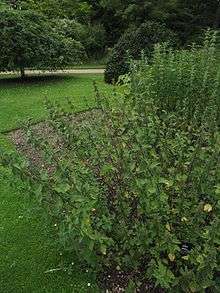
Taxonomy
The taxonomy of Urtica species has been confused, and older sources are likely to use a variety of systematic names for these plants. Formerly, more species were recognised than are now accepted. However, at least six clear subspecies of U. dioica are described, some formerly classified as separate species:
- U. dioica subsp. dioica (European stinging nettle), from Europe, Asia, and northern Africa, has stinging hairs.
- U. dioica subsp. galeopsifolia (fen nettle or stingless nettle), from Europe, does not have stinging hairs.
- U. dioica subsp. afghanica, from southwestern and central Asia, sometimes has stinging hairs or is sometimes hairless.[6]
- U. dioica subsp. gansuensis, from eastern Asia (China), has stinging hairs.[6]
- U. dioica subsp. gracilis (Ait.) Selander (American stinging nettle), from North America, has stinging hairs.
- U. dioica subsp. holosericea (Nutt.) Thorne (hoary stinging nettle), from North America, has stinging hairs.[7]
Other species names formerly accepted as distinct by some authors but now regarded as synonyms of one or other subspecies include U. breweri, U. californica, U. cardiophylla, U. lyalli, U. major, U. procera, U. serra, U. strigosissima, U. trachycarpa, and U. viridis.
Distribution
U. dioica is abundant in northern Europe and much of Asia, usually found in the countryside. It is less widespread in southern Europe and north Africa, where it is restricted by its need for moist soil, but is still common. In North America, it is widely distributed in Canada and the United States, where it is found in every province and state except for Hawaii, and also can be found in northernmost Mexico. It grows in abundance in the Pacific Northwest, especially in places where annual rainfall is high. The European subspecies has been introduced into North America and South America.[8][9]
In Europe, nettles have a strong association with human habitation and buildings. The presence of nettles may indicate the site of a long-abandoned building. Human and animal waste may be responsible for elevated levels of phosphate[10] and nitrogen in the soil, providing an ideal environment for nettles.
Ecology
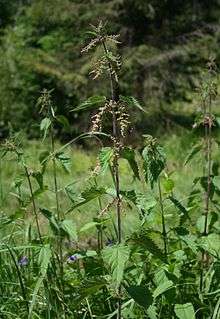
Nettles are the exclusive larval food plant for several species of butterflies, such as the peacock butterfly[11] or the small tortoiseshell, and are also eaten by the larvae of some moths including angle shades, buff ermine, dot moth, the flame, the gothic, grey chi, grey pug, lesser broad-bordered yellow underwing, mouse moth, setaceous Hebrew character, and small angle shades. The roots are sometimes eaten by the larva of the ghost moth Hepialus humuli.
Stinging nettle is particularly found as an understory plant in wetter environments, but it is also found in meadows. Although nutritious, it is not widely eaten by either wildlife or livestock, presumably because of the sting. It spreads by abundant seeds and also by rhizomes, and is often able to survive and re-establish quickly after fire.[12]
Nettle sting treatment
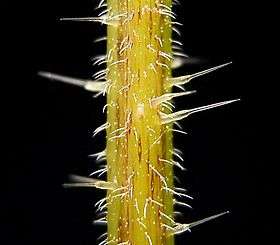
Anti-itch drugs, usually in the form of creams containing antihistaminics or hydrocortisone may provide relief from the symptoms of being stung by nettles.[13] Because of the combination of chemicals involved, though, other remedies may be required. Calamine lotion may be helpful. Many folk remedies exist for treating the itching, including dandelion, horsetail (Equisetopsida spp.), leaf of dock (Rumex spp.), greater plantain, jewelweed (Impatiens capensis and Impatiens pallida), the underside of a fern (the spores), mud, saliva, or baking soda, oil and onions, lemon juice, and topical use of milk of magnesia.[13]
Influence on language and culture
In Great Britain and Ireland, the stinging nettle (U. dioica subsp. dioica) is the only common stinging plant and has found a place in several figures of speech in the English language. Shakespeare's Hotspur urges that "out of this nettle, danger, we pluck this flower, safety" (Henry IV, part 1, Act II Scene 3). The figure of speech "to grasp the nettle" probably originated from Aesop's fable "The Boy and the Nettle".[14] In Seán O'Casey's Juno and the Paycock, one of the characters quotes Aesop "Gently touch a nettle and it'll sting you for your pains/Grasp it as a lad of mettle and soft as silk remains". The metaphor may refer to the fact that if a nettle plant is grasped firmly rather than brushed against, it does not sting so readily, because the hairs are crushed down flat and do not penetrate the skin so easily.[15]
In the German language, the idiom sich in die Nesseln setzen, or to sit in nettles, means to get into trouble. In Hungarian, the idiom csalánba nem üt a mennykő (no lightning strikes the nettle) means bad things never happen to bad people. The same idiom exists in the Serbian language неће гром у коприве. In Dutch, a netelige situatie means a predicament. In French, the idiom faut pas pousser mémé dans les orties (don't push grandma in the nettles) means that we should be careful not to abuse a situation. The name urticaria for hives comes from the Latin name of nettle (Urtica, from urure, to burn).
The English word 'nettled', meaning irritated or angry, is derived from 'nettle'.[16]
Uses
Food
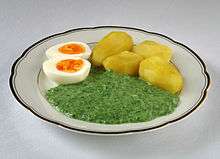
U. dioica has a flavour similar to spinach mixed with cucumber when cooked, and is rich in vitamins A and C, iron, potassium, manganese, and calcium. Young plants were harvested by Native Americans and used as a cooked plant in spring when other food plants were scarce.[17] Soaking stinging nettles in water or cooking removes the stinging chemicals from the plant, which allows them to be handled and eaten without injury. After the stinging nettle enters its flowering and seed-setting stages, the leaves develop gritty particles called cystoliths, which can irritate the urinary tract.[17] In its peak season, nettle contains up to 25% protein, dry weight, which is high for a leafy green vegetable.[18] The leaves are also dried and may then be used to make a herbal tea, as can also be done with the nettle's flowers.
Nettles can be used in a variety of recipes, such as polenta, pesto, and purée.[19] Nettle soup is a common use of the plant, particularly in Northern and Eastern Europe. In Nepal (सिस्नो in Nepali) and the Kumaon and Gargwal region of northern India, stinging nettle is known as sisnu, kandeli, and bicchū-būṭī (Hindi: बिच्छू-बूटी), respectively. It is also found in abundance in Kashmir, where it is called soi.
Nettles are sometimes used in cheesemaking, for example in the production of Cornish Yarg[20] and as a flavouring in varieties of Gouda.[21]
Nettles are used in Albania as part of the dough filling for the börek. Its name is byrek me hithra. The top baby leaves are selected and simmered, then mixed with other ingredients such as herbs and rice, before being used as a filling between dough layers.[22][23] Similarly, in Greece the tender leaves are often used, after simmering, as a filling for hortopita, which is similar to spanikopita, but with wild greens rather than spinach for filling.[24]
Competitive eating
In the UK, an annual World Nettle Eating Championship draws thousands of people to Dorset, where competitors attempt to eat as much of the raw plant as possible. Competitors are given 60 cm (24 in) stalks of the plant, from which they strip the leaves and eat them. Whoever strips and eats the most stinging nettle leaves in a fixed time is the winner. The competition dates back to 1986, when two neighbouring farmers attempted to settle a dispute about which had the worst infestation of nettles.[25][26]
Drink
Nettle leaves are steeped in a concentrated sugar solution to extract the flavour. The leaves are then removed and a source of citric acid (usually lemon juice) is added to help preserve the cordial and add a tart flavour.
Commercially produced cordials are generally quite concentrated and are usually diluted by one part cordial to ten parts water – thus a 0.5 l (0.11 imp gal; 0.13 US gal) bottle of cordial would be enough for 5.5 litres (1.2 imp gal; 1.5 US gal) diluted. The high concentration of sugar in nettle cordial gives it a long shelf life.
Also, many recipes for alcoholic nettle beer are used, which is a countryside favourite in the British Isles.[27]
Traditional medicine
U. dioica herb has been used in the traditional Austrian medicine internally (as tea or fresh leaves) to treat disorders of the kidneys and urinary tract, gastrointestinal tract, locomotor system, skin, cardiovascular system, hemorrhage, influenza, rheumatism, and gout.[28]
As Old English stiðe, nettle is one of the nine plants invoked in the pagan Anglo-Saxon Nine Herbs Charm, recorded in the 10th century. Nettle was believed to be a galactagogue, a substance that promotes lactation.[29]
Urtication, or flogging with nettles, is the process of deliberately applying stinging nettles to the skin in order to provoke inflammation. An agent thus used is known as a rubefacient (something that causes redness). This is done as a folk remedy for treatment of rheumatism.[30]
Textiles and fibre

Nettle stems contain a bast fibre that has been traditionally used for the same purposes as linen and is produced by a similar retting process. Unlike cotton, nettles grow easily without pesticides. The fibres are coarser, however.[31]
Historically, nettles have been used to make clothing for 2,000 years, and German Army uniforms were almost made from nettle during World War I due to a potential shortage of cotton. More recently, companies in Austria, Germany, and Italy have started to produce commercial nettle textiles.[32][33]
The fibre content in nettle shows a high variability and reaches from below 1% to 17%. Under middle-European conditions, stems yield typically between 45 and 55 dt / ha, which is comparable to flax stem yield. Due to the variable fibre content, the fibre yields vary between 0.2 and 7 dt / ha, but the yields are normally in the range between 2 and 4 dt / ha.[34] Fibre varieties are normally cloning varieties and therefore planted from vegetative propagated plantlets. Direct seeding is possible, but leads to great heterogeneity in maturity.[35]
Nettles may be used as a dye-stuff, producing yellow from the roots, or yellowish green from the leaves.[36]
Feed
Nutrient contents
Fresh leaves contain approximately 82.4% water, 17.6% dry matter, 5.5% protein, 0.7 to 3.3% fat, and 7.1% carbohydrates.[37] Mature leaves contain about 40% α- linolenic acid, a valuable omega-3 acid.[38] For exact fatty acid contents see Table 1. Seeds contain much more fatty acid than leaves.[38]
|
Table 1: Fatty acid content of different plant organs of U. dioica.[38] | ||||||
| Mature Leaves | Young Leaves | Seeds | Stems | Roots | ||
|---|---|---|---|---|---|---|
| Moisture (% fresh weight) | 72.8 (± 5.1) | 82.0 (± 3.7) | 47.6 (± 2.1) | 50.1 (± 2.4) | 40.3 (±2.8) | |
| Saponifiable oil (% fresh weight) | 2.1 (± 0.3) | 3.3 (± 0.2) | 15.1 (± 2.0) | 1.5 (± 0.1) | 0.1 (± 0.0) | |
|
Fatty acids (% of saponifiable oil) | ||||||
| Palmitic | 16:0 | 17.9 (± 1.1) | 20.1 (± 0.9) | 25.4 (± 1.9) | 23.6 (± 2.1) | 24.0 (± 0.8) |
| Palmitoleic | 16:1n-7 | 3.0 (± 0.2) | 3.9 (± 0.3) | 0.7 (± 0.0) | 0.5 (± 0.0) | 2.6 (± 0.3) |
| Stearic | 18:0 | 1.6 (± 0.3) | 1.9 (± 0.1) | 2.3 (± 0.3) | 1.8 (± 0.2) | 1.6 (± 0.1) |
| Oleic | 18:1n-9 | 1.7 (± 0.2) | 2.8 (± 0.2) | 4.8 (± 0.3) | 2.1 (± 0.2) | 8.7 (± 0.5) |
| Linoleic | 18:2n-6 | 11.6 (± 1.0) | 18.1 (± 1.3) | 22.7 (± 1.9) | 33.8 (± 2.9) | 34.3 (± 2.7) |
| α- Linolenic | 18:3n-3 | 40.7 (± 3.2) | 29.6 (± 2.1) | 6.6 (± 4.9) | 12.2 (± 1.0) | 2.3 (± 0.1) |
| Gadoleic | 20:1n-9 | 0.8 (± 0.0) | 0.7 (± 0.0) | 2.1 (± 0.2) | 1.5 (± 0.1) | 1.2 (± 0.0) |
| Erucic | 22:1n-9 | 0.4 (± 0.0) | 0.5 (± 0.1) | 1.2 (± 0.2) | 0.9 (± 0.2) | 0.9 (± 0.1) |
| Omega-3 : Omega-6 Ratio | n-3/n-6 | 3.51 | 1.64 | 0.29 | 0.65 | 0.07 |
Minerals (Ca, K, Mg, P, Si, S, Cl) and trace elements (Mn, Cu, Fe) contents depend mostly on the soil and the season.[37]
Nettle contains different secondary metabolites. Carotenoids can be found primarily in the leaves, where different forms of lutein, xanthophyll and carotene are present (Table 2). Some carotenes are precursors of vitamin A (retinol), their retinol equivalents RE or retinol activity equivalents per g dry weight are 1.33 for mature leaves and 0.9 for young leaves.[37] Nettle contains much less than carotenes and retinol than carrots, which contain 8.35 RE per g fresh weight.[39] Depending on the batch and the leave and stem content, nettle contains only traces of zeaxanthin or between 20 – 60 mg / kg of dry matter.[37][40] Nettle contains ascorbic acid (vitamin C), riboflavin (vitamin B2), pantothenic acid, vitamin K1[37] and tocopherols (vitamin E).[40] The highest vitamin contents can be found in the leaves.[37]
|
Table 2: Carotenoid concentration of leaves of U. dioica (μg/ g dry weight).[38] | |||
| Mature leaves | Young leaves | ||
|---|---|---|---|
| Total identified carotenoids | 74.8 | 51.4 | |
| Xanthophylls | Neoxanthin | 5.0 (± 0.2) | 2.6 (± 0.2) 0 |
| Violaxanthin | 11.0 (± 0.2) | 7.2 (± 0.6) | |
| Zeaxanthin | traces | traces | |
| β-cryptoxanthin | traces | traces | |
| Luteins | 13-cis-lutein | 0.4 (± 0.0) | 0.4 (± 0.0) |
| 13’-cis-lutein | 8.4 (± 0.4) | 5.0 (± 0.6) | |
| All-trans-lutein | 32.4 (± 1.0) | 23.6 (± 0.8) | |
| 9-cis-lutein | 1.2 (± 0.2) | 1.0 (± 0.2) | |
| 9’-cis-lutein | 4.4 (± 0.4) | 3.4 (± 0.6) | |
| Carotenes | All-trans-β-carotene | 5.6 (± 0.7) | 3.8 (± 0.3) |
| β-carotene-cis-isomers | 4.8 (± 0.2) | 3.2 (± 0.2) | |
| Lycopene | 1.6 (± 0.1) | 1.2 (± 0.1) | |
| Retinol equivalent | RE / g dry wt | 1.33 (± 0.3) | 0.90 (± 0.3) |
Poultry: Egg yolk colouring in laying hens
In laying hens, nettle can be used as an egg yolk colorant instead of artificial pigments or other natural pigments (derived from marigold for yellow). Nettle has high carotenoid contents, especially lutein, β-carotene and zeaxanthin, of which lutein and zeaxanthin act as yellow pigments.[40] [41][42]Feeding as little as 6.25 g dry nettle per kg feed is as effective as the synthetic pigments to colour the egg yolk. Feeding nettle has no detrimental effect on the performance of the laying hens or the general egg quality.[40]
Ruminants
Nettles do not sting only humans; animals also do not like to touch fresh stinging nettle. If the nettle are wilted or dry, voluntary intake can be high. Dry nettle shoots are said to be “as good as good alfalfa hay”. As with other leafy herbs with relatively hard stems, the harvest should be done carefully to avoid leave drop losses. Nettle can be conserved as hay or silage.
|
Table 3: Contents of ryegrass and nettle silage [43] | |||
| Ryegrass Silage | Nettle Silage | ||
|---|---|---|---|
| Dry matter | DM | 235 | 415 |
| Metabolizable energy (MJ/ kg DM) | ME | 11.3 | 9.8 |
| Crude Protein | CP | 177 | 171 |
| Neutral detergent fibre | aNDF | 536 | 552 |
| Acid detergent fibre | ADF | 338 | 434 |
| Starch | - | - | |
| Ash | 113 | 118 | |
Gardening
Nettles have a number of other uses in the vegetable garden, including the potential for encouraging beneficial insects. Since nettles prefer to grow in phosphorus-rich and nitrogen rich soils that have recently been disturbed (and thus aerated), the growth of nettles is an indicator that an area has high fertility (especially phosphate and nitrate), and thus is an indicator to gardeners as to the quality of the soil.[44][45]
Nettles contain a lot of nitrogenous compounds, so are used as a compost activator[46] or can be used to make a liquid fertilizer, which although somewhat low in phosphate, is useful in supplying magnesium, sulphur, and iron.[47][48] They are also one of the few plants that can tolerate, and flourish in, soils rich in poultry droppings.
Recent experiments have shown that nettles are a beneficial weed, having use as a companion plant.[49]
U. dioica can be a troubling weed, and mowing can increase plant density.[50] Regular and persistent tilling will greatly reduce its numbers, and the use of herbicides such as 2,4-D and glyphosate are effective control measures.[50]
Field cultivation
Sowing and planting[51]
Three cultivation techniques can be used for the stinging nettle: 1) direct sowing, 2) growing seedlings in nurseries with subsequent transplantation and 3) vegetative propagation via stolons or head cuttings.
- Direct sowing: The seedbed should have a loose and fine structure, but should be reconsolidated using a packer roller imminently prior to sowing.[52] Sowing time can be either in autumn[53] or in spring.[54] Seed density should be 6 kg/ha with row spacing of 30 centimetres (12 in) and 42–50 cm in autumn and spring, respectively.[52][53][55] The disadvantage of direct sowing is that it usually leads to incomplete plant coverage.[52][55] This drawback can be mitigated by covering the seedbed with a transparent perforated foil in order to improve seed germination.[52][53] Further, weed control can be problematic as the stinging nettle has a slow seedling development time.[52]
- Growing seedlings: For this technique pre-germinated seeds are sown between mid-/end-February and beginning of April and grown in nurseries. Seedlings are grown in tuffs with 3-5 plants / tuff and a seed density of 1.2-1.6 kg / 1000 tuffs. A fastened germination is achieved by alternating high temperature during daytime (30 °C for 8 h) and lower temperature during nighttime (20 °C for 16 h).[52][55] Before transplanting, the seedlings should be fertilized and acclimated to cold temperatures.[52] Transplantation should start around Mid-April with row spacing of 42–50 centimetres (17–20 in) and plant spacing within rows of 25–30 cm.[54][55]
- Vegetative propagation: Stolons (with several buds) of 10 cm should be planted from Mid-April in a depth of 5–7 centimetres (2.0–2.8 in).[54] Head cuttings are grown in nurseries starting between mid-May and mid-June. Growing tips with two leaf-pairs are cut from the mother plant and treated with root-growth inducing hormones. Transplantation can be delayed in comparison to the growing seedling technique.[52]
Greenhouse cultivation[56]
The stinging nettle can also been grown in controlled-environment agriculture (CEA) systems, such as soil-less medium cultivations or aeroponics.
According to a study,[56] CEA systems can achieve much higher yields, standardize the quality, as well as reduce harvesting costs and contamination.
Etymology
Urtica is derived from a Latin word meaning 'sting'.[57]
Dioica is derived from Greek, meaning 'of two houses' (having separate staminate and pistillate plants; dioecious).[57]
Gallery
- Young shoot
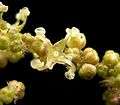 Flowers (male) can be yellow
Flowers (male) can be yellow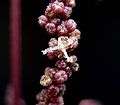 Flowers (male) can be purple
Flowers (male) can be purple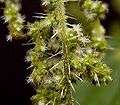 Flowers (female) can be green and white
Flowers (female) can be green and white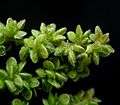 Fruits
Fruits
See also
References
- 1 2 "Burning & Stinging Nettles". University of California. Retrieved 21 September 2013.
- ↑ Per Brodal (2010). The Central Nervous System: Structure and Function. Oxford University Press US. p. 170. ISBN 978-0-19-538115-3. Retrieved 22 September 2010.
- 1 2 Nettle (Stinging). Wildflowerfinder.org.uk. Retrieved on 3 July 2012.
- ↑ Louis J. Casarett; Curtis D. Klaassen; John Doull (2008). Casarett and Doull's toxicology: the basic science of poisons. McGraw-Hill Professional. pp. 1104–. ISBN 978-0-07-147051-3. Retrieved 22 September 2010.
- ↑ Michael I. Greenberg (4 June 2003). Occupational, industrial, and environmental toxicology. Elsevier Health Sciences. pp. 180–. ISBN 978-0-323-01340-6. Retrieved 22 September 2010.
- 1 2 Chen Jiarui; Ib Friis; C. Melanie Wilmot-Dear. "Flora of China online". efloras, Missouri Botanical Garden, St. Louis, MO & Harvard University Herbaria, Cambridge, MA.
- ↑ "Plant For a Future database".
- ↑ "Species: Urtica dioica". United States Forest Service. Retrieved 21 September 2013.
- ↑ "Stinging Nettle". Ohio Agricultural Research and Development Center, Ohio State University. Retrieved 21 September 2013.
- ↑ Smith, Paul L. (2012). Indicator Plants: Using Plants to Evaluate the Environment. p. 47.
- ↑ Heiko Bellmann: Der Neue Kosmos Schmetterlingsführer, Schmetterlinge, Raupen und Futterpflanzen, pg. 170, Frankh-Kosmos Verlags-GmbH & Co, Stuttgart 2003, ISBN 3-440-09330-1.
- ↑ Carey, Jennifer H. (1995). "Urtica dioica". Fire Effects Information System, [Online].
- 1 2 "Urtica dioica (Stinging Nettles)". University of Wisconsin-La Crosse. Retrieved 22 September 2013.
- ↑ "The Project Gutenberg eBook of The Æsop For Children, by Æsop". Gutenberg.org. 2 December 2006. Retrieved 5 July 2010.
- ↑ Doug (5 September 2010). "Grasping the nettle: an empirical enquiry". Retrieved 6 September 2010.
- ↑ "nettled". Oxford English Dictionary (3rd ed.). Oxford University Press. September 2005. (Subscription or UK public library membership required.)
- 1 2 Gregory L. Tilford, Edible and Medicinal Plants of the West, ISBN 0-87842-359-1
- ↑ Hughes, R. Elwyn; Ellery, Peter; Harry, Tim; Jenkins, Vivian; Jones, Eleri (1980). "The dietary potential of the common nettle". Journal of the Science of Food and Agriculture. 31 (12): 1279–86. PMID 6259444. doi:10.1002/jsfa.2740311210.
- ↑ 1069 Recetas de Cocina (No 423). Wattpad.com (12 May 2010). Retrieved on 3 July 2012.
- ↑ "Lynher Dairies Nettles & Garlic". Lynherdairies.co.uk. Retrieved 5 July 2010.
- ↑ "Gouda Cheese with Stinging Nettles: Cooking Terms". RecipeTips.com. Retrieved 5 July 2010.
- ↑ "Byrek me hithra" (in Albanian). Hermes News. 19 March 2012. Retrieved 14 May 2017.
- ↑ "Byrek me hithra" [Recipe: Nettles Pie] (in Albanian). 13 February 2013. Retrieved 14 May 2017.
- ↑ "What’s In Your Horta?". Greek Cooking. GreekBoston. Retrieved 14 May 2017.
- ↑ "World nettle eating championships". BBC News. 17 June 2005. Retrieved 3 July 2012.
- ↑ Langley, William. (14 June 2009) World Stinging Nettle Eating Championship attracts record crowd. The Daily Telegraph (London). Retrieved on 3 July 2012.
- ↑ Andy Hamilton (29 October 2009). "Nettle beer recipe". Selfsufficientish.com. Retrieved 21 September 2015.
- ↑ Vogl, S; Picker, P; Mihaly-Bison, J; Fakhrudin, N; Atanasov, AG; Heiss, EH; Wawrosch, C; Reznicek, G; Dirsch, VM; Saukel, J; Kopp, B (2013). "Ethnopharmacological in vitro studies on Austria's folk medicine - An unexplored lore in vitro anti-inflammatory activities of 71 Austrian traditional herbal drugs". J Ethnopharmacol. 149: 750–71. PMC 3791396
 . PMID 23770053. doi:10.1016/j.jep.2013.06.007.
. PMID 23770053. doi:10.1016/j.jep.2013.06.007. - ↑ Westfall R.E. (2003). "Galactagogue herbs: a qualitative study and review". Canadian Journal of Midwifery Research and Practice. 2 (2): 22–27.
- ↑ "Stinging Nettles". BBC. Retrieved 21 September 2013.
- ↑ "Student shows off nettle knickers". BBC News. 1 July 2004. Retrieved 24 May 2010.
- ↑ Neustatter, Angela (27 February 2008). "Rash thinking". The Guardian.
- ↑ Flintoff, John-Paul (20 August 2009). "Second skin: why wearing nettles is the next big thing". The Ecologist.
- ↑ Wurl, Günter; Graf, Torsten; Vettel, Armin; Biertümpfel, Andrea. "10 Jahre anbautechnische Versuche zu Fasernesseln (Urtica dioica L.) in Thüringen" (PDF). Thüringer Landesanstalt für Landwirtschaft.
- ↑ Vogl, C. R.; Hartl, A. (2003). "Production and processing of organically grown fiber nettle (Urtica dioica L.) and its potential use in the natural textile industry: A review" (PDF). American Journal of Alternative Agriculture. 18: 119–128. doi:10.1079/AJAA200242.
- ↑ Piers Warren, 101 uses for Stinging Nettles (2006), p. 65, ISBN 0-9541899-9-X.
- 1 2 3 4 5 6 Lutomski, Jerzy; Speichert, Henryk (1983). "Die Brennessel in Heilkunde und Ernährung". Pharmazie in unserer Zeit (in German). 12: 181–186. doi:10.1002/pauz.19830120602.
- 1 2 3 4 Guil-Guerrero, J. L.; Rebolloso-Fuentes, M. M.; Torija Isasa, M. E. (2003). "Fatty acids and carotenoids from Stinging Nettle (Urtica dioica L.)". Journal of Food Composition and Analysis. [{Elsevier]]. 16 (2): 111–119. doi:10.1016/S0889-1575(02)00172-2.
- ↑ "USDA National Nutrient Database: raw carrot". Retrieved 28 November 2015.
- 1 2 3 4 Loetscher, Y.; Kreuzer, M.; Messikommer, R. E. (13 December 2013). "Utility of nettle (Urtica dioica) in layer diets as a natural yellow colorant for egg yolk". Animal Feed Science and Technology. Elsevier. 186 (3-4): 158–168. doi:10.1016/j.anifeedsci.2013.10.006.
- ↑ Loetscher, Y.; Kreuzer, M.; Messikommer, R. E. (2013). "Oxidative stability of the meat of broilers supplemented with rosemary leaves, rosehip fruits, chokeberry pomace, and entire nettle, and effects on performance and meat quality". Poultry Science. 92: 2938–2948. doi:10.3382/ps.2013-03258.
- ↑ Keshavarz, Mehdi; Rezaeipour, Vahid; Asadzadeh, Sakineh (2014). "Growth Performance, Blood Metabolites, Antioxidant Stability and Carcass Characteristics of Broiler Chickens Fed Diets Containing Nettle (Urtica dioica. L) Powder or Essential Oil". International Journal of Advanced Biological and Biomedical Research. 2 (9): 2553–2561. ISSN 2322-4827.
- ↑ Humphries, David J.; Reynolds, Chris K. (March 2014). "The effect of adding stinging nettle (Urtica dioica) haylage to a total mixed ration on performance and rumen function of lactating dairy cows". Animal Feed Science and Technology. Elsevier. 189: 72–81. doi:10.1016/j.anifeedsci.2014.01.006.
- ↑ "Indicator Weeds and Soil Conditions at". Garden-helper.com. Retrieved 5 July 2010.
- ↑ "virtual-herb-walk". Herbalpractitioner.com. Retrieved 5 July 2010.
- ↑ "h2g2 – Stinging Nettles". BBC DNA. Retrieved 5 July 2010.
- ↑ Pears, Pauline, et al. HDRA Encyclopedia Of Organic Gardening, p. 207, Dorling Kindersley Ltd, London, 2005.
- ↑ "Compost Teas vs Other Teas and Extracts". Ciwmb.ca.gov. Retrieved 5 July 2010.
- ↑ "'Stinging Nettle: Companion Plant and Medicinal Herb'". bcliving.ca. 8 May 2009. Retrieved 16 June 2012.
- 1 2 Wood Powell Anderson (1999). Perennial weeds: characteristics and identification of selected herbaceous species. Wiley-Blackwell. pp. 25–. ISBN 978-0-8138-2520-5. Retrieved 17 October 2010.
- ↑ Heyland, Klaus-Ulrich (2006). "Ölfrüchte, Faserpflanzen, Arzneipflanzen und Sonderkulturen". Handbuch des Pflanzenbaues. Stuttgart: Ulmer. Band 4.
- 1 2 3 4 5 6 7 8 Bomme, U. (1996). "Kulturanleitung für Brennnesseln". Bayerische Landesanstalt für Bodenkultur und Pflanzenbau, Abteilung Pflanzenbau und Pflanzenzüchtung, LBP Freising. München.
- 1 2 3 Heeger, E. F. (1956). "Handbuch des Arznei- und Gewürzpflanzenbaus". Leipzig: Deutscher Bauernverlag.
- 1 2 3 Bomme U.; Unterholzerner S (1996). "Günstigste Verfahren zum Anbau der Grossen Brennnessel". Gemüse 3: 233–234.
- 1 2 3 4 Dachler M.; Pelzmann H. (1999). "Arznei- und Gewürzpflanzen.". Anbau — Ernte — Aufbereitung. 2. Auflage. Wien: Österreichischer Agrarverlag (VUA).
- 1 2 Pagliarulo, C.L.; Hayden, A.L.; Giacomelli, G.A. (2004). "Potential for greenhouse aeroponic cultivation of Urtica dioica". Acta Horticulturae. 659: 61–66.
- 1 2 Gledhill, David (2008). "The Names of Plants". Cambridge University Press. ISBN 9780521866453 (hardback), ISBN 9780521685535 (paperback). pp 142, 395
Further reading
- Elliott, C. (1997). "Rash Encounters". Horticulture. 94: 30.
- Schofield, Janice J. (1998). Nettles ISBN 0-585-10500-6
- Thiselton-Dyer, T. F., (1889). The Folk-Lore of Plants.
- Glawe, G. A. (2006). Sex ratio variation and sex determination in Urtica diocia. ISBN 90-6464-026-2
External links
| Wikimedia Commons has media related to Stinging nettle. |
- "Urtica dioica L.". Germplasm Resources Information Network (GRIN). Agricultural Research Service (ARS), United States Department of Agriculture (USDA).
- Flora of China: Urtica dioica